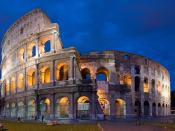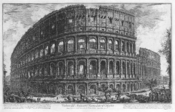In the ancient world, the elliptical-shaped Colosseum, taking ten years to build, was the largest structure of its type. It stood 160 feet high with four stories of windows, arches, and columns. Each of the three exterior floors consisted of 80 arches. As many as 50,000 spectators with numbered tickets entered through 76 of the entrances on the ground level. Two of the remaining entrances were used by Emperor Titus and two for the gladiators.
Upon entering the Colosseum, visitors climbed sloping ramps to their seats, according to gender and social class. Women and the poor stood or sat on wooden benches in the fourth tier. Depending on the weather, an enormous, colored awning (velarium) could be stretched overhead to prevent the hot sun from coming in on the spectators.
A wooden flooring was used to cover the subterranean chambers where the gladiators as well as the animals were kept prior to performance.
During the first ten years of its existence, the stadium was filled with water and used for mock naval battles. However, over time the Romans found it was damaging to the foundation as well as to the flooring.
Most shows in the Colosseum lasted all day beginning with comedic contests and exotic animal shows in the morning and moving on to professional gladiator events in the afternoon. In most tournaments and games, death played a prominent role. Professional gladiators, primarily condemned criminals, prisoners or war, and slaves, fought either animals or each other, generally until death. Their weapons might include nets, swords, tridents, spears, or firebrands. Occasionally, free Romans and women would enter the fight for a few brief moments of glory. Contrary to common belief, there is no documentation to back up the story of Christians being fed to the lions.
Basically these bloody forms...
![[Forum Boario, Rome, Italy] (LOC)](https://s.writework.com/uploads/17/171586/forum-boario-rome-italy-loc-thumb.jpg)

